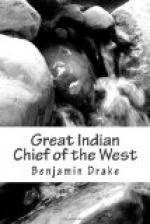During the winter they were visited by a great number of persons, one of whom remarks, “We were immediately struck with admiration at the gigantic and symmetrical figures of most of the warriors, who seemed as they reclined, in native ease and gracefulness, with their half naked bodies exposed to view, rather like statues from some master hand, than beings of a race whom we had heard characterized as degenerate and debased. They were clad in leggins and moccasins of buckskin, and wore blankets, which were thrown around them in the manner of the Roman toga, so as to leave their right arms bare. The youngest among them were painted on their necks, with a bright vermilion color, and had their faces transversely streaked, with alternate red and black stripes. From their faces and eyebrows, they pluck out the hair with the most assiduous care. They also shave or pull it out from their heads, with the exception of a tuft about three fingers width, extending from between the forehead and crown to the back of the head; this they sometimes plait into a queue on the crown, and cut the edges of it down to an inch in length, and plaster it with the vermilion which keeps it erect, and gives it the appearance of a cock’s comb.” The same writer adds, that, “but for the want of that peculiar expression which emanates from a cultivated intellect,” Nasinewiskuk, the eldest son of Black Hawk, could have “been looked upon as the very personification, of the beau ideal of manly beauty.” Among their many visitors while at this place, was the distinguished author of the “Sketch Book,” who in a letter, under date of 18th of Dec. 1832, says, “From St. Louis, I went to Fort Jefferson, about nine miles distant, to see Black Hawk, the Indian warrior and his fellow prisoners—a forlorn crew—emaciated and dejected—the redoubtable chieftain himself, a meagre old man upwards of seventy. He has, however, a fine head, a Roman style of face, and a prepossessing countenance."[13] When Catlin the artist, visited Jefferson Barracks for the purpose of painting the portraits of these chiefs, and was about to commence the likeness of Naopope, he seized the ball and chain that were fastened to his leg, and raising them on high, exclaimed with a look of scorn, “make me so, and show me to the great father.” Upon the artist’s refusing to paint him as he wished, he kept varying his countenance with grimaces, to prevent him from catching a likeness.
During the visit of Keokuk to Jefferson Barracks, he made exertions to obtain the release of the prisoners, pledging himself to the Indian agent at St. Louis, and to General Atkinson, to be responsible for their good conduct in future. Soon afterwards, however, the General received orders from the secretary at war to have the prisoners sent to Washington city. It was in the latter part of April, 1833, that they reached the capitol, under the escort of an officer of the army. In the first interview between President




